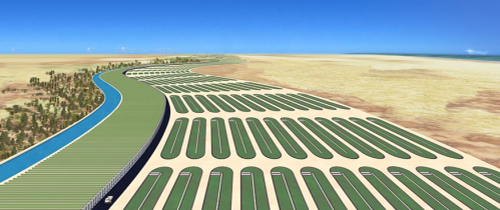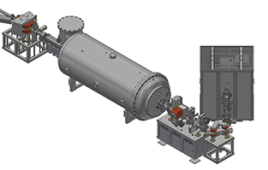
An artist’s concept of a commercial algae harvesting facility on land unfit for agricultural use. (Credit: Algaeconsortium.com)
Scientists have uncovered a plethora of uses for microalgae including as green energy and food sources.
Charles Greene, professor of earth and atmospheric sciences at Cornell University and lead author of the new paper “Marine Microalgae: Climate, Energy and Food Security from the Sea,” said utilizing microalgae could result in the next green revolution.
“I think of algae as providing food security for the world,” he said in a statement. “It will also provide our liquid fuels needs, not to mention its benefits in terms of land use. We can grow algae for food and fuels in only one-tenth to one one-hundredth the amount of land we currently use to grow food and energy crops.
“We can relieve the pressure to convert rainforests to palm plantations in Indonesia and soy plantations in Brazil,” Greene added. “We got into this looking to produce fuels, and in the process, we found an integrated solution to so many of society’s greatest challenges.”
The study is an overview of the concept of large-scale industrial cultivation of marine microalgae (ICMM).
This concept could reduce fossil fuel use by supplying liquid hydrocarbon biofuels for the aviation and cargo shipping industries.
After the lipids have been removed for biofuels the biomass of microalgae remaining can then be made into nutritious animal feeds or even food consumed by humans.
The scientists harvested freshly grown microalgae, removed most of the water and then extracted the lipids to make the biofuel.
After the biofuel is produced, the remaining defatted biomass is a protein-rich and highly nutritious byproduct—one that can be added to feeds for domesticated farm animals like chicken and pigs or aquacultured animals like salmon and shrimp.
According to previous Cornell research, after consuming the algae-supplemented feeds, chickens produce eggs with three times the omega-3 fatty acids as before.
However, an 800,000-square-mile area would be needed to grow enough algae to meet the current global liquid fuel demands but 2.4 billion tons of protein co-product would also be generated, which is roughly 10 times the amount of soy protein produced globally each year.
Locations like Mexico, North Africa, the Middle East and Australia would provide suitable locations for producing vast amounts of microalgae because of they have an arid, subtropical climate.
According to Greene, a commercial microalgae facility of about 2,500 acres would cost between $400 million and $500 million.
“That may seem like a lot of money but integrated solutions to the world’s greatest challenges will pay for themselves many times over during the remainder of this century,” he said. “The costs of inaction are too steep to even contemplate.”
The study, which was published in Oceanography, can be viewed here




